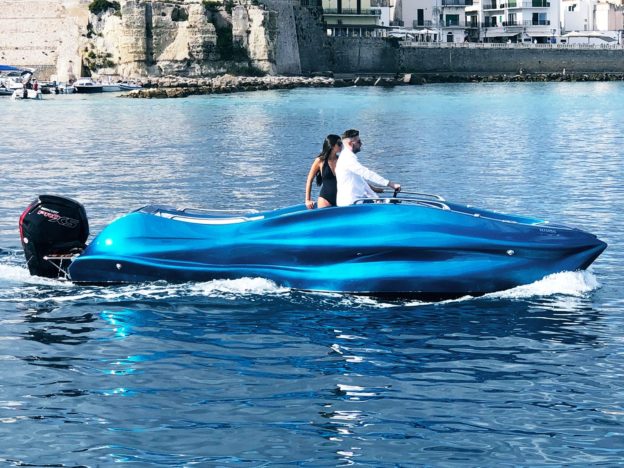Summary List Placement
Recent 3D-printing technology has advanced immensely, with the process now being used to create complex products like houses, face shields, aerospace components, and much more. Now one manufacturing startup just built what it’s calling the very first 3D-printed fiberglass boat.
Italian firm Moi Composites created MAMBO (short for Motor Additive Manufacturing Boat) to show off its 3D-printing capabilities, specifically a process called “continuous fiber manufacturing.” Moi says the process lets it create shapes that would be too expensive or all-around impossible with traditional manufacturing practices.
And MAMBO certainly exemplifies that – the striking boat has an organic, flowing design and an “inverted tricycle” shape that looks like nothing else on the water.
Moi displayed the vessel at the Genoa Boat Show earlier this month, but didn’t release any plans to manufacture it at scale. Learn a bit more about MAMBO below:SEE ALSO: Hyundai just formed a division to build walking vehicles that can drive at highway speeds and climb walls
Tech startup Moi Composites built a striking boat called MAMBO to demonstrate its 3D-printing chops — and it’s calling the vessel “the world’s first 3D printed fiberglass boat.”
Moi built the vessel using a method called “continuous fiber manufacturing,” which allows it to create unusual, organic shapes that aren’t possible with conventional processes, the company says.
“The creativity of many designers today is suppressed due to various factors: technological, geometric limits, or production costs,” Moi said in a press release. “And there are countless noteworthy projects, destined to remain magnificent renderings forever.”
Those designs can become reality thanks to CFM, according to Moi Composites.
Algorithm-guided robots built the boat in sections by printing out continuous fibers infused with thermosetting resin.
Other fiber-reinforced printing methods use tiny pieces of fiber to strengthen the final product, while continuous fiber manufacturing feeds in long strands, making the item stronger and stiffer.
Moi then joined the sections together to create a boat that it says is strong, durable, and lightweight.
According to Moi, its manufacturing process allows it to create products that are mechanically similar to ones made from traditional, unidirectional fiberglass.
But Moi doesn’t use traditional models, molds, or tooling equipment, reportedly making it easier and more efficient to create prototypes, one-offs, or small-batch products.
The boat has what Moi calls a “reverse tricycle” shape, whereby the bow is split in two.
Moi built Mambo to promote its manufacturing technology, but the boat is fully seaworthy, too.
The 21-foot boat sports a navigation system, cork flooring, leather seats, and a 113-horsepower engine.
Moi built the vessel with high-profile partners like Autodesk, Owens Corning, and Catmarine, and showed it off at the Genoa Boat Show in early October.

Comments are closed